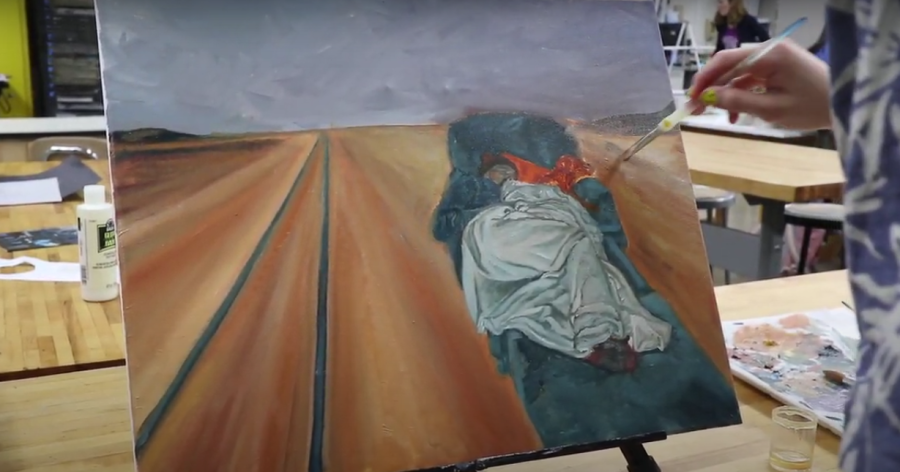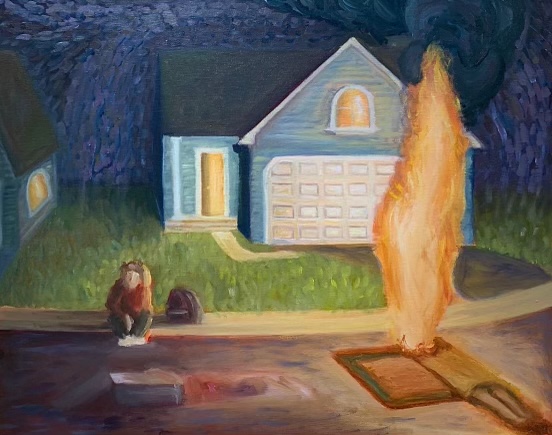A look into AP Studio Art at Neuqua
Vivian Durkin adding to a painting for the AP Studio Art portfolio.
May 24, 2022
As the year comes to an end and artists in Mrs. Sammit’s AP Studio Art Class finish their portfolios, it is important to look back on the impact that this awesome class has had on its students. Although this is not a traditional art class due to its independent nature, the students who take it often classify it as one of their favorite classes offered at Neuqua. Artists as well as Mrs. Sammit, the AP Studio Art teacher, reflect on the effects that this class has on aspiring young artists.
Question: “What is your portfolio type and what materials do you like to use?”
Sara Sienkiewicz: “My portfolio is a 3-D portfolio and this year I am doing ceramics so I am using clay, a potter’s wheel and glazes.”
Grace Panek: “I am doing a drawing portfolio. I like to work in graphite, occasionally ink pens, and then I use paintbrushes to blend.”
Vivian Durkin: “I am doing an AP drawing portfolio for AP Studio Art and I am using mainly oil paints, oil pastels but also colored pencils.”
Kelsey Jones: “My portfolio type is a drawing portfolio. I started off using graphite and pencils because that’s what I was best at but then I started to experiment with more paint. I actually just recently did a watercolor painting and I tried to broaden my material use.”
Question: “What is the topic of your essential question and what are you exploring this year?”
Sara Sienkiewicz: “My essential question is how 3-D principals are used in different cultural ceramics around the world.”
Grace Panek: “I am exploring parenting and family dynamics and how those things can affect different people in a household.”
Vivian Durkin: “My question concerns the LGBTQ+ experience and in that experience I know that people kind of recognize that there’s a lot of struggle being a minority group. However, I am trying to also express while how the LGBTQ+ community does face struggles, they also are a very beautiful community and I want to recognize that in my work.”
Kelsey Jones: “Right off the bat, I kind of was really inspired about my journey through mental health so I wanted to just draw whatever came to mind about the different kind of things that mental health can put a human through. So I was really inspired by what I have gone through and what I’ve also seen other people have gone through and I’d also love to spread awareness as well, that is one of my biggest goals. At the end of the year once everything is completed, I would love to share my art with everyone just to let them know that they are not alone and this is what these things can look like.”
Question: “How has developing this portfolio helped shape your understanding of your chosen topic and how has it enhanced your process as an artist?”
Sara Sienkiewicz: “It made me realize how universal art is and how different cultures are affected by how they portray their art through colors and movement, throughout all their pieces.”
Grace Panek: “I definitely think doing these pieces has helped me find a space to go into more detail about these topics. In terms of my techniques as an artist, I’ve learned a lot more this year about how to have better quality artwork, being more patient with my artwork, and putting more time into it so I can develop a greater final product.”
Vivian Durkin: “Originally going into this, I was more focused on a fine arts portfolio and leaning towards just using oil paints on canvas. I did a lot of still life and portrait figured paintings mainly, however, I have kind of moved more almost abstract expressionism in my work and a lot of mark making as well, in order to convey the emotional depth of what I wanted in my portfolio. I even started using Crayola oil pastels which is a little bit nontraditional because they are intended for children, but I actually really like the consistency of them and how they’ve come out in my work.”
Kelsey Jones: “Once I knew that I was going to do a portfolio about mental health, I right away started researching what kinds of mental health disorders and diseases there are. I made a list of all of them and I kind of just googled what they meant, what they looked like, in order to get a good visual on those types of things. I haven’t really been the best at sketching out my ideas because I like going into things right away, so this year has taught me how to prepare yourself and experiment, since I was not that big on experimenting before, but it has definitely helped me throughout my art process.”
Question: “How is teaching an independent class, such as AP Studio Art, different from teaching less independent classes?”
Mrs.Sammit: “I think AP Studio class is a lot less teaching of technical skills and more of guidance on the AP Rubric and helping students reach those objectives. I also think that I talk so much less in AP Studio and I am more quiet where I try to listen a lot more. A lot of times it is me questioning students and trying to help them figure out their ideas and how to synthesize those ideas with appropriate materials, acting more as a cheerleader than so much as giving technical instructions.”
Question: “Do you see any change on how students approach their artwork at the beginning of the year versus the end of the year?”
Mrs.Sammit: “I think students towards the end of the year get a lot more confidence. In the beginning of the year, there might be a little more tentative approach or maybe second guessing. Students also tend to work a lot slower and take their time on getting things perfect. The confidence level definitely increases towards the end of the year and that comes with understanding their sustain investigation and their concept a lot better so they are able to see that through several different iterations. By the end, a lot of people seem to be soaring and the creative juices seem to be flowing. It’s always exciting to see students come into their own, and to find their artistic voice and aesthetic sense of ability. At the end of the year, you can see what everyone’s style is and how they begin to embrace that.”



